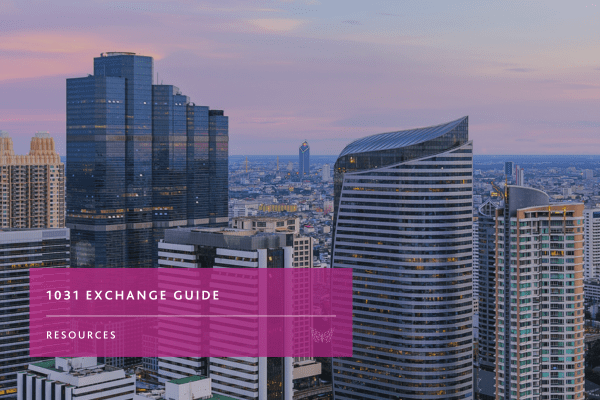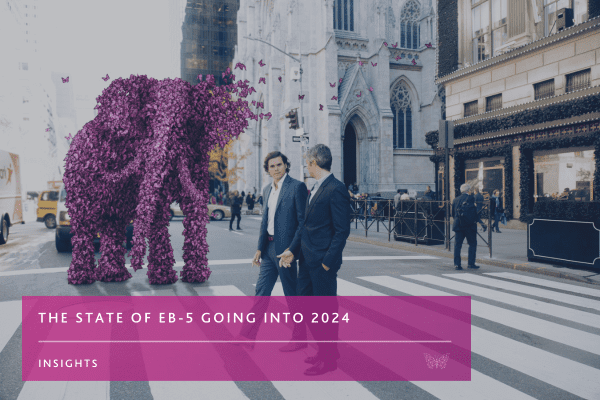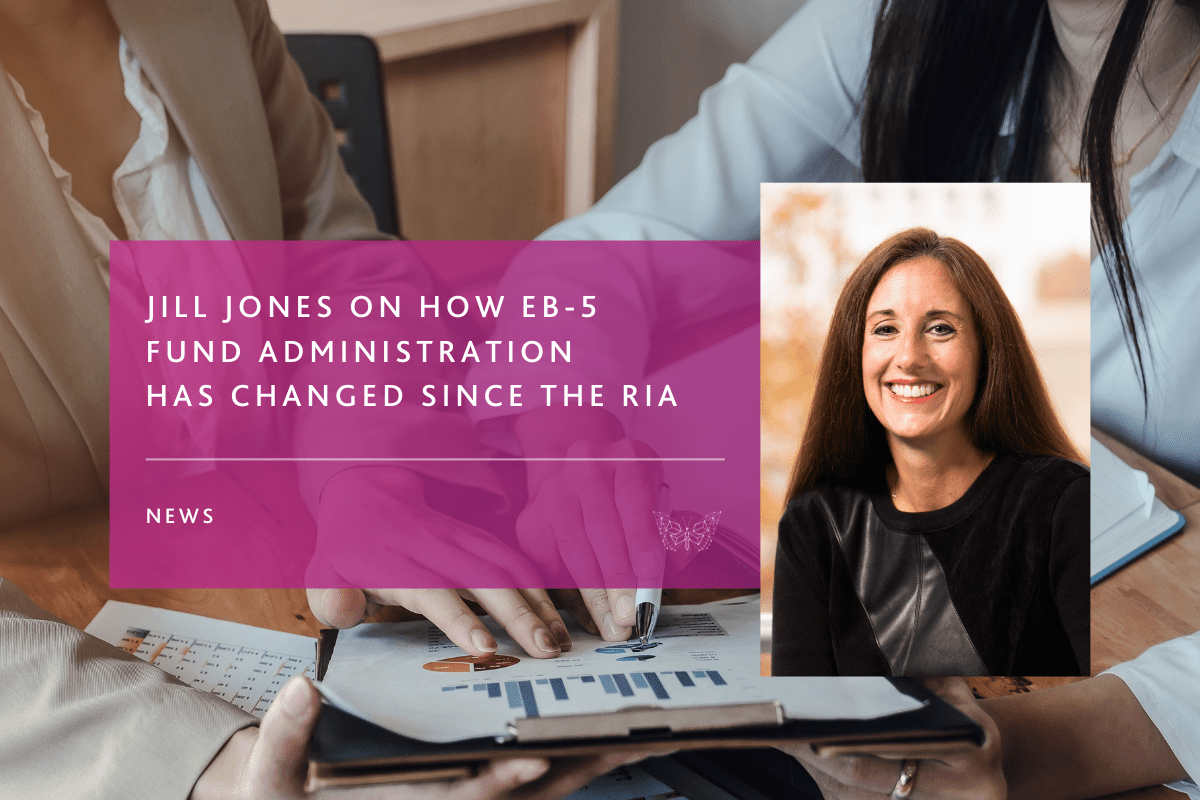The biggest questions surrounding the EB-5 Immigrant Investor Program as we enter the new year.
2023 was an eventful year for EB-5. New USCIS guidance helped confirm some of the most impactful elements of the EB-5 Reform and Integrity Act of 2022, potentially shaking up the industry in a big way. At the same time, banking crises at American regional banks highlighted the need for greater flexibility and security in EB-5 banking solutions.
As we head into 2024 with a full year of post-RIA activity under our belts, it’s important to take a look at how the industry has adjusted to the new era of the Regional Center program and where things stand right now in order to better predict where we might be headed in the future.
How did EB-5 fare in 2023?
As we near the two-year mark since the passage of the RIA, many experts are optimistic about the state of EB-5. Hundreds of Regional Centers have been approved, with more than a billion dollars of investment raised for EB-5 projects since the passage of the RIA. While the industry has seen a resurgence thanks to the Regional Center program’s renewal, there have been some challenges.
The real estate market and the aforementioned banking crises created a lot of hesitation, and there continues to be a lack of clarity from USCIS on many issues. With little information being given out, litigation has been required to obtain rulings that might give investors greater confidence in the projects in which they’ve invested.
Despite these issues, investors are showing increased interest in the program, and fundraising data has been encouraging. Will these trends continue in 2024? That remains to be seen. Here are some questions that remain, and what current evidence points toward as we enter the new year.
How will the current economy affect EB-5 investing in 2024?
As EB-5 investment is tied to immigration, trends in EB-5 investing are affected by more than just economic factors. That said, understanding the state of the U.S. commercial real estate sector can help us get a sense of the choices investors have and how good different options may look in 2024.
At a November webinar from CanAm Enterprises entitled, “The U.S. Economy: 2023 Trends and Looking Forward to 2024,” an expert panel discussed how recent economic trends might affect EB-5. According to Brian Rose, Ph.D., Senior Economist Americas at UBS Global Wealth Management, interest rate hikes to combat inflation have not caused a recession as some expected.
“Even as the fed has raised rates, the economy has remained strong,” he said. He added that interest rates were likely to fall in 2024, since inflation has seen significant reduction from its peak of 9%. “We’ve already made a lot of progress towards reducing inflation,” he said.
High interest rates have made the dollar strong, making the U.S. economy a reliable currency for investment amid inflationary pressures in other countries. Once interest rates are cut, this benefit may be reduced, but for now, the U.S. may be seen as a safe haven for investors from countries where their cash may be losing value due to currency devaluation.
Emilio Miguel, Regional Head – Americas for JTC Group’s Private Client Services division, also stressed the benefits of U.S. stability. “What we see in these times of difficulty is people lean more towards preservation of capital rather than growth,” he said, adding that the U.S. is generally seen as a secure place to invest and buy property.
As we wait for interest rates to fall, commercial real estate projects may find traditional sources of financing lacking, increasing the need for EB-5 capital. An abundance of projects looking for equity investments or mezzanine debt (where EB-5 investments commonly fall in a capital stack) has afforded private lenders an excess of choices in terms of where to put their capital.
While it’s true commercial real estate didn’t have a great year in 2023 (some estimates say more than 17% of U.S. office supply is vacant), Rose cautioned that we shouldn’t be overly pessimistic.
“Commercial real estate is not just office buildings,” he said, adding that as private funds step in to purchase assets from foreclosures and defaults, prices aren’t likely to collapse. “The outlook really isn’t too bad for commercial real estate.”
In summation, while the U.S. economy hasn’t completely recovered from the inflation crisis, nor has commercial real estate recovered from the vacancies created by the pandemic’s shift to remote work, opportunities abound for private investors. As commercial real estate transforms, EB-5 investors will likely find an abundance of projects to choose from.
Will EB-5 investment increase in 2024? Decrease? Stay the same?
After EB-5 investment slumped during the lapse of the Regional Center program, it was expected to rebound following passage of the RIA. What we didn’t know at the time was how much it would rebound, or how long it would take to do so. Recent data from 2023 has been encouraging. According to IIUSA, the volume of I-526 case filings increased by 215% in 2023, with the amount of EB-5 funds raised returning to pre-pandemic levels.
The numbers for filings and fundraising can only increase in 2024 if there are enough EB-5 projects to meet investor demand. How many projects are actively fundraising? A recent report on I-956F applications states that 185 I-956F forms were received in FY2023. Given that there were 379 I-956 Regional Center applications filed as of September 2023, it wouldn’t be foolish to expect even more projects in 2024 as new Regional Centers are approved.
Demand was also expected to increase post-RIA because of the new rural and high-unemployment set-aside categories, which allow investors from countries like China and India to take advantage of reserved visas to get around the backlogs facing those countries. Recent data shows investors are taking advantage of these categories, with 69% of all I-526/I-526E applications falling in a high-unemployment TEA and 24% in a rural TEA.
Overall I-526 filings are up from 2022, and with carryover visas potentially available, this number could easily go up in 2024. In short, there is every reason to believe EB-5 investment and visa demand will increase in 2024 as more Regional Centers are approved, more projects are available, and more investors seek to take advantage of visa availability.
Will EB-5 wait times go up or down in 2024?
I-526 and I-829 processing times will vary because of reserved visa categories. Unreserved visas will be behind legacy applications in the queue, so we need to look at how fast USCIS is processing those applications, which must be adjudicated before post-RIA applications. According to IIUSA:
“In FY2023, USCIS increased productivity in processing legacy I-526 cases by 176%, leading to a continued decline in the number of pending petitions. As of October 1, 2023, there were 9,257 legacy I-526 cases pending at USCIS, marking the first time in the last 10 years that the number of pending I-526 cases dropped below 10,000.”
A decline in the number of pending petitions is good, as it means future petitions may be processed sooner. However, these petitions may still take a long time, especially compared to applications in reserved categories. There have already been reports of rural I-526 applications being approved within a year, validating the promise of the reserved visa categories and making those set-aside visas even more valuable to petitioners seeking fast adjudication.
One wrinkle in the RIA’s provisions for set-aside visas is that while reserved visas will carry over to the same category the following year, in the year after that they will carry over without the restriction. As explained in a recent article, “reserved EB-5 visas from FY 2022 that weren’t used that year or in FY 2023 were passed on as unreserved for 2024.” This means an increase in available unreserved visas, not just in reserved categories, which is good news for all investors.
Across the industry, forecasts for visa availability in the next year look good, and greater availability should lead to shorter wait times. But this all relies upon USCIS to efficiently process applications. It has been extremely difficult to get information out of USCIS in the wake of the RIA, and this lack of transparency means a reduction in wait times can’t be taken for granted.
What will happen with reserved EB-5 visa categories in 2024?
As the WR Immigration forecast states, “There are over 8,100 visas available in the reserved category in FY 2024, and it’s unlikely sufficient demand will be created to exceed this supply, so the reserved visa categories will remain ‘current’ in the visa bulletin for the foreseeable future.”
Rural and high-unemployment visas have proven popular, representing the vast majority of new I-526 filings. So long as the category remains current, this will likely continue to be true. As we discussed in our recent blog on rural projects, there is a learning curve for rural EB-5 projects due to the complications of labor sources, industry, and potential tenant base in those areas. Quality projects may be difficult to find, meaning demand will outpace supply in the near future.
For more on rural EB-5 projects in 2024, read our blog post on the subject.
Which countries will be key sources of EB-5 investment in 2024?
We’ve previously discussed how the RIA has changed EB-5 investment strategies based on an applicant’s home country, and the expectation that EB-5 investment from China and India would increase thanks to reserved categories. China and India still lead the way in visa issuance and this is likely to continue so long as reserved visas allow investors to circumvent the backlog of applications from those countries.
Another likely source of EB-5 applicants is the U.S. itself. Thanks to layoffs in the tech industry, individuals who were on H1-B visas may now look to EB-5 because concurrent filing of adjustment of status will allow them to stay in the country and continue to work while applications are processing. These investors may be most interested in projects near the areas where they already live, and their familiarity with the U.S. and its markets could mean issuers will have to step things up to provide the transparency they’re looking for.
At the CanAm Webinar, Miguel said Latin America was poised to become a greater source for EB-5 capital. Unstable governments in some countries may make high net-worth individuals (HNWI) more likely to move capital outside their countries and possibly relocate to the U..S, where 30% of Latin American wealth booked offshore is already invested. Given that there are an estimated 600,000 HNWI in Latin America, if more decide to relocate to the U.S., we could see a significant increase in LATAM EB-5 investment.
One thing that makes JTC different from other EB-5 fund administration providers is our broad range of services. We have expertise in the deployment of LATAM capital in the U.S., and offer Private Client Services to HNWI around the world. We can work with EB-5 investors to help them get settled in their new countries while also providing the immigration workflow they need for their applications. By combining those services with JTC’s fund administration, escrow, cosignatory, and other EB-5 solutions, we’re able to offer Regional Centers a level of service that will set them apart in a crowded marketplace.
Learn more about JTC’s EB-5 solutions.
Stay Connected
Stay up to date with expert insights, latest updates and exclusive content.
Discover more
Stay informed with JTC’s latest news, reports, thought leadership, and industry insights.
Let’s Bring Your Vision to Life
From 2,300 employee owners to 14,000+ clients, our journey is marked by stability and success.


















